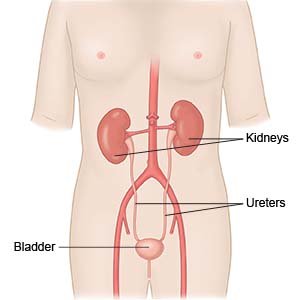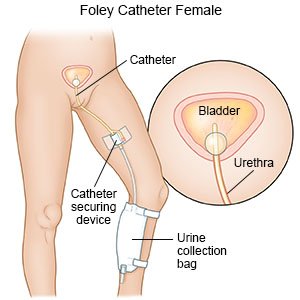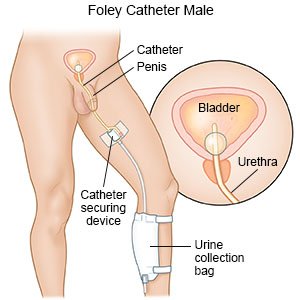Robot Assisted Laparoscopic Ureter Reimplantation
Medically reviewed by Drugs.com. Last updated on Aug 4, 2025.
AMBULATORY CARE:
What you need to know about robot assisted laparoscopic ureter reimplantation (RALUR):
RALUR is surgery to fix the position of the ureters through small incisions in your child's abdomen. RALUR is done with a machine that is controlled by your child's surgeon. The machine has mechanical arms that use small tools to help perform the surgery.
 |
How to prepare your child for surgery:
- Your child's surgeon will tell you how to prepare your child. The surgeon may tell you not to give your child anything to eat or drink after midnight on the day of the surgery.
- Tell your child's surgeon about all medicines your child currently takes. The surgeon will tell you if your child needs to stop any medicine for the surgery, and when to stop. The surgeon will tell you which medicines to give or not give your child on the day of surgery.
- Tell the surgeon about any allergies your child has, including to anesthesia or medicines.
- Your child's surgeon will tell you if your child needs any tests before surgery, and when to have them.
What will happen during surgery:
- Your child will be given general anesthesia to keep him or her asleep and free from pain during surgery. A urinary catheter will be inserted while your child is asleep. This helps drain urine from your child's bladder.


- The surgeon will make 3 small incisions in your child's abdomen. Surgical tools are attached to the arms of the robot. The arms will be used to place a laparoscope and other tools inside your child's abdomen. A laparoscope is a long, thin tube with a light and camera on the end.
- The surgeon will guide the robotic arms and use small tools to detach the ureter from the bladder. A tunnel will be made into the muscle of the bladder. The ureter will be reimplanted into the tunnel and sewn into place with stitches. The abdominal incisions will be closed with stitches or skin adhesive tape and covered with a bandage.
What your child should expect after RALUR:
- Your child will be taken to a recovery room until he or she wakes up. Healthcare providers will monitor your child for any problems. Your child will then be taken to his or her hospital room. Your child will need to stay in the hospital for at least 1 night. Your child may need to stay longer depending on his or her recovery.
- The urinary catheter will stay in place until your child's ureters work properly. Your child may be sent home with the urinary catheter in place. Healthcare providers will teach you how to care for the catheter at home.
Risks of RALUR:
Your child may bleed more than expected or develop an infection. The ureters may not connect properly to the bladder or may leak urine. The surgeon may need to change the surgery from laparoscopic to open. This means your child will need 1 large incision. The kidneys, bladder, or other nearby organs may be damaged. Your child may need another surgery to fix organ damage.
Related medications
Seek care immediately if:
- Your child urinates less than usual or not at all.
- Your child's stitches come apart.
- Blood soaks through your child's bandage.
- Your child's incision sites are red, swollen, and draining pus.
Call your child's doctor if:
- Your child has a fever.
- Your child has nausea or vomits.
- You have questions or concerns about your child's condition or care.
Medicines:
Your child may need any of the following:
- Acetaminophen decreases pain and fever. It is available without a doctor's order. Ask how much to give your child and how often to give it. Follow directions. Read the labels of all other medicines your child uses to see if they also contain acetaminophen, or ask your child's doctor or pharmacist. Acetaminophen can cause liver damage if not taken correctly.
- Do not give aspirin to children younger than 18 years. Your child could develop Reye syndrome if he or she has the flu or a fever and takes aspirin. Reye syndrome can cause life-threatening brain and liver damage. Check your child's medicine labels for aspirin or salicylates.
- Give your child's medicine as directed. Contact your child's healthcare provider if you think the medicine is not working as expected. Tell the provider if your child is allergic to any medicine. Keep a current list of the medicines, vitamins, and herbs your child takes. Include the amounts, and when, how, and why they are taken. Bring the list or the medicines in their containers to follow-up visits. Carry your child's medicine list with you in case of an emergency.
Care for the incision sites as directed:
Do not let the sites get wet until the surgeon says it is okay. When it is okay to bathe your child, do not scrub the sites. Just let water run over the sites. Gently pat-dry the sites and put on new, clean bandages as directed. Change your child's bandages when they get wet or dirty. Do not put powders or lotions over your child's incision sites. Check the sites every day for signs of infection, such as swelling, redness, or pus.
Follow up with your child's surgeon as directed:
Follow up within 1 week if your child has a urinary catheter. Your child will need to return in 4 to 6 weeks to check if his or her ureters are working properly. Write down your questions so you remember to ask them during your visits.
© Copyright Merative 2025 Information is for End User's use only and may not be sold, redistributed or otherwise used for commercial purposes.
The above information is an educational aid only. It is not intended as medical advice for individual conditions or treatments. Talk to your doctor, nurse or pharmacist before following any medical regimen to see if it is safe and effective for you.
Further information
Always consult your healthcare provider to ensure the information displayed on this page applies to your personal circumstances.
